Mixing colors is hard. It’s a skill I’ve always been decent at but I’ve also never really dedicated time to getting better at it. I was an art minor in college and spent a good amount of time learning about color. So I know how to mix colors, I just never really cared to do it. And for a lot of people, it can be really frustrating.
I go to the art store most weekends. Even if it’s just to walk around and get out of the house for a bit. Recently, I started noticing more paint coming in CMYK sets. I even came across a watercolor set like this. I’m currently in the middle of a painting and decided it might be fun to switch things up a bit and I grabbed a few bottles of fluid acrylics to play with.
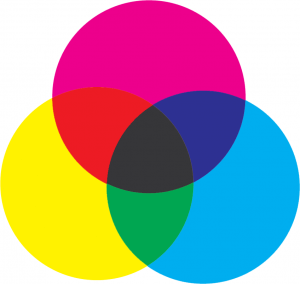
My whole life everyone has pushed RYB for color and I never really understood why. Even in art school they pushed RYB without even really mentioning any other color models, like RGB and CMYK. RGB is really used for light, like televisions and monitors and smartphones. CMYK is used more for physical objects where light is reflected off a surface. That’s why you’ve probably had an inkjet printer with 4 different color cartridges. In CMYK, Red and Blue are not primary colors, they’re secondary colors. Red and blue can all be mixed from CMY. Okay, I’m going off onto a tangent… this isn’t the point of this post.
Whether you want to mix with RYB or CMY, the process will be the pretty much same (though you may need to do some math to figure out the ratios in RGB). I chose to buy the CMY colors, so that is what I’ll be working with in this post.
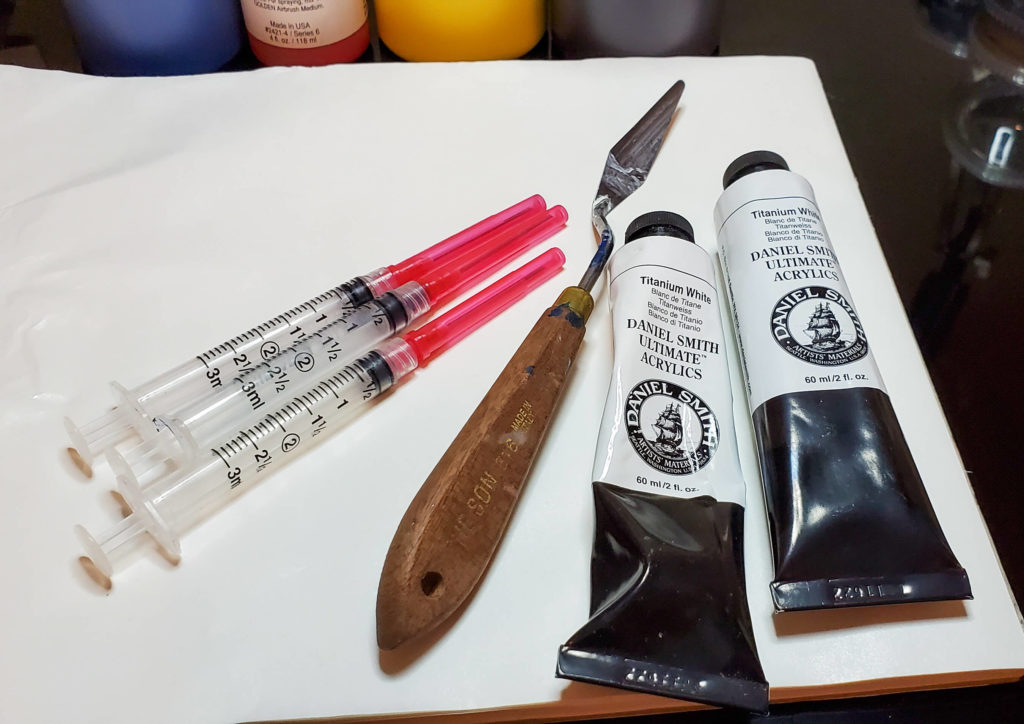
I decided to use fluid acrylics for ease of measuring. I’ll be using blunt needles to suck up some acrylic right out of the bottle. I also grabbed a palette knife and popsicle sticks to do some mixing (depending on the container I’m using) and some white paint to use as a base. I also grabbed (not pictured) a gel base to bulk up my mixture.

You’ll also need some containers to store your paint in. I usually use these plastic Twisterz containers to keep my paint around until the end of a project. If it’s a color I really like or I’m doing a series of paintings that I foresee needing a lot of the same color, I use some empty paint tubes (and a tube wringer) to store my paint in so I can keep it pretty much air free.
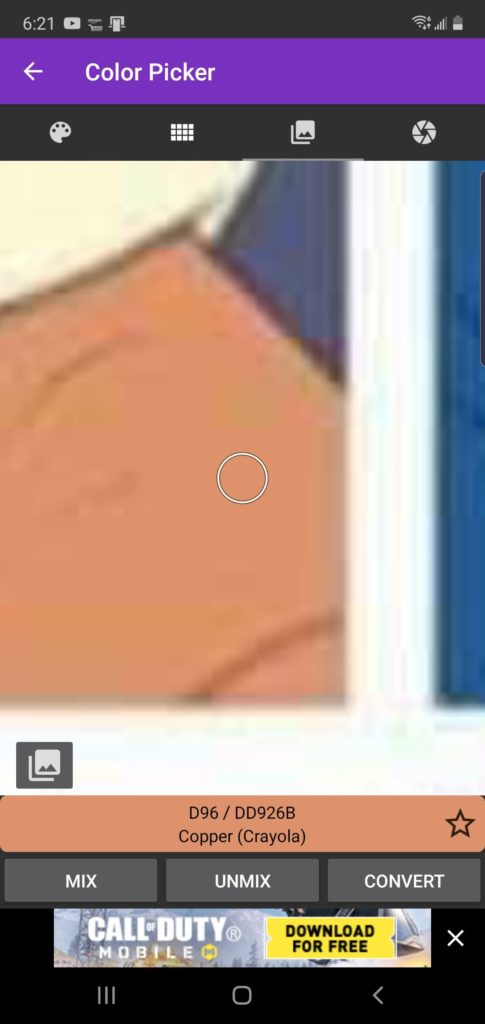
I’m working from an image someone sent me when they requested I do a painting. Using an app called “Color Mixer” on android, I zoomed in and selected the color in the image to grab the color code. Most color apps will work and if you’re on a computer just about any photo editing software will give you a color code as well. This particular app gives the color in HTML Hex so I’ll need to convert it to CMYK.
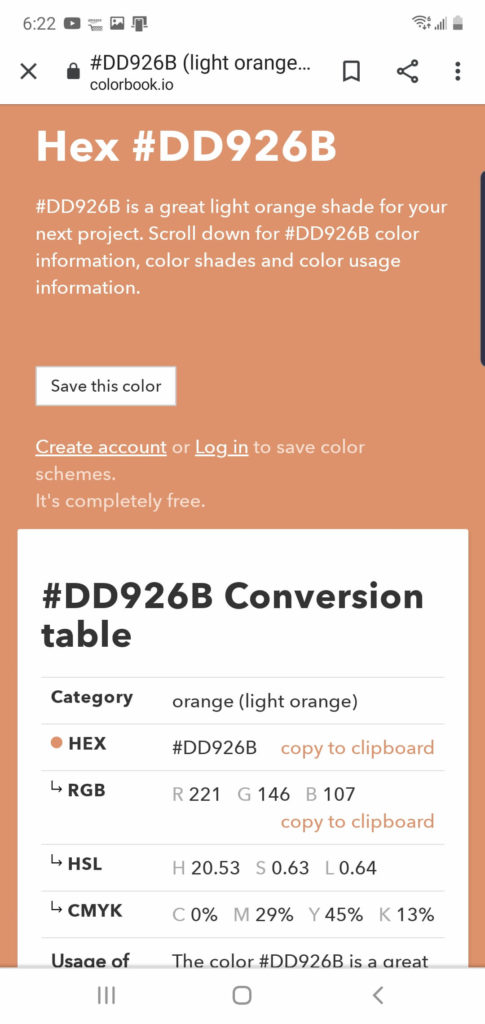
A quick google search later, the website colorbook.io converted my Hex code to a list of other formats. I’ll grab the CMY color percents and get to mixing. You can ignore the K (black) percent.
Using my blunt needle, I’ll pull 29 units (depends on how you are measuring) magenta and deposit it into either into a container or onto a palette for mixing.
I do want to note that the percentage given in the CMYK chart above doesn’t add up to 100%. Those percentages are a percentage of coverage, not a percentage of total paint. I’m not spraying ink onto paper but I will still get pretty close to my goal color using these ratios as a guide. If you really want precision you could look into Pantone spot color formulas.
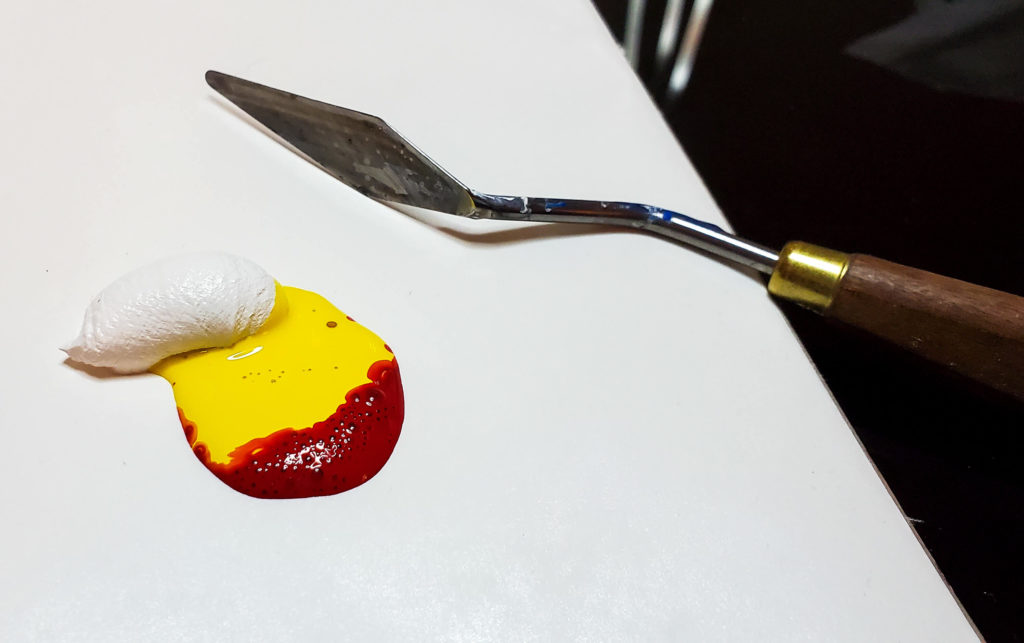
Along with those fluids, I’ll add a gob of white. Titanium White will lessen the transparency of the fluid acrylics and also give the paint body.
If you don’t care about the body of the paint, you can also just mix into white fluid acrylic, which will give you a pretty opaque fluid. This will be similar to painting with house paint and will leave minimal brush strokes on your canvas. It really depends on your preference and what you want the resulting texture to be.

A quick mix later and I have my color. It’s at this point where I can change the brightness of the paint by adding more white or adding some black (a very tiny amount at a time). In person, the color was really close so I just left it alone. With the camera, I’m using and some adjustments in Photoshop, it looks like it is a bit too light here.
Then to bulk it up, I often will and a gob of medium to make sure I have enough for my project.

The problem with gel medium is that it will introduce more transparency to your paint. I normally have to put down 2 or 3 coats to get solid coverage with a heavy body paint straight from a tube. The addition of the gel medium usually means an additional coat.
The orange in the photo is 1 coat. I also did the yellow using this same method and that took about 3 coats.
The number of coats doesn’t bother me as long as I can get to the desired result. I like working in large solid colors so I am fine with additional coats of paint. Read the label of your medium, if you choose to use one, and keep the level of transparency it has in mind.

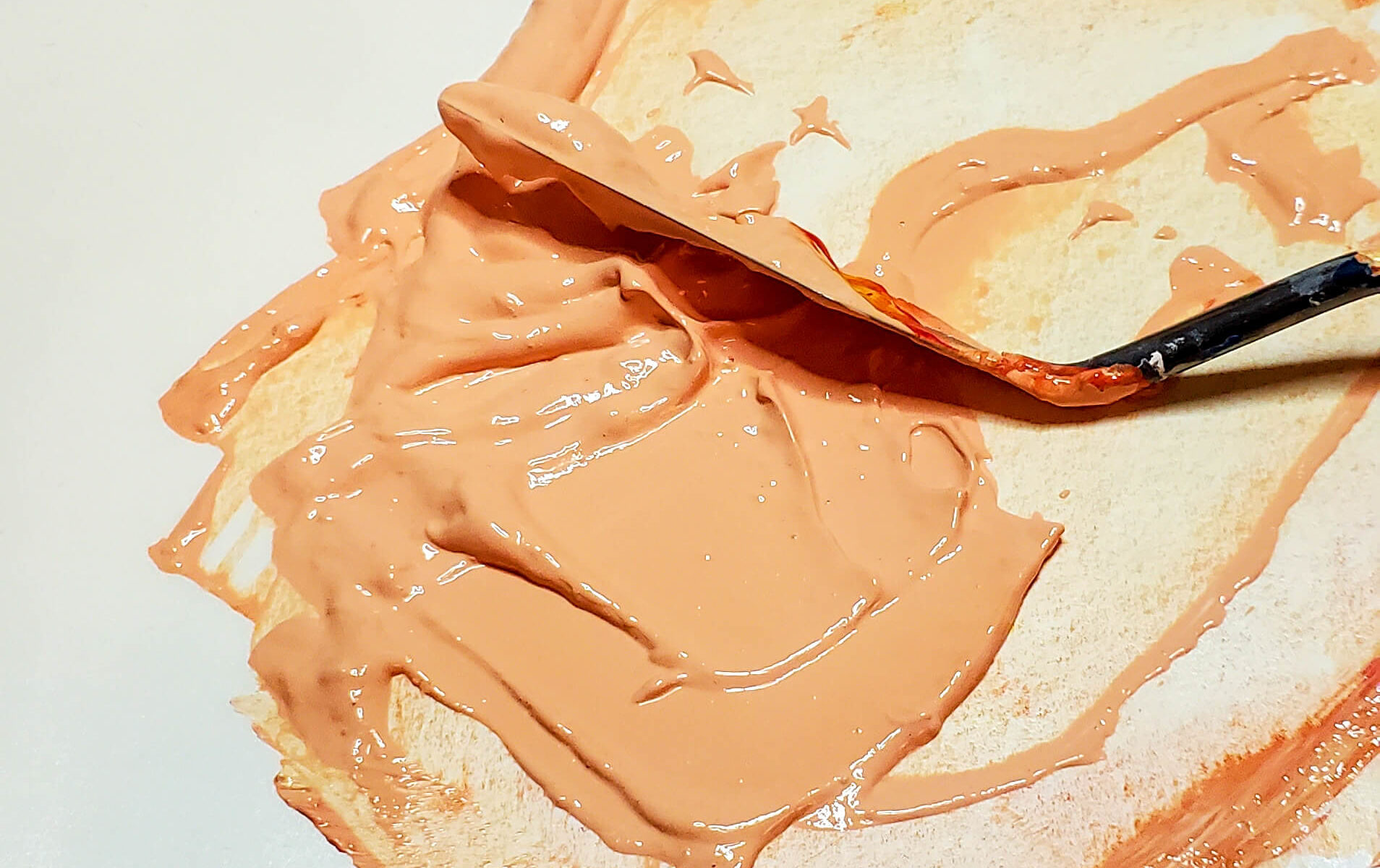

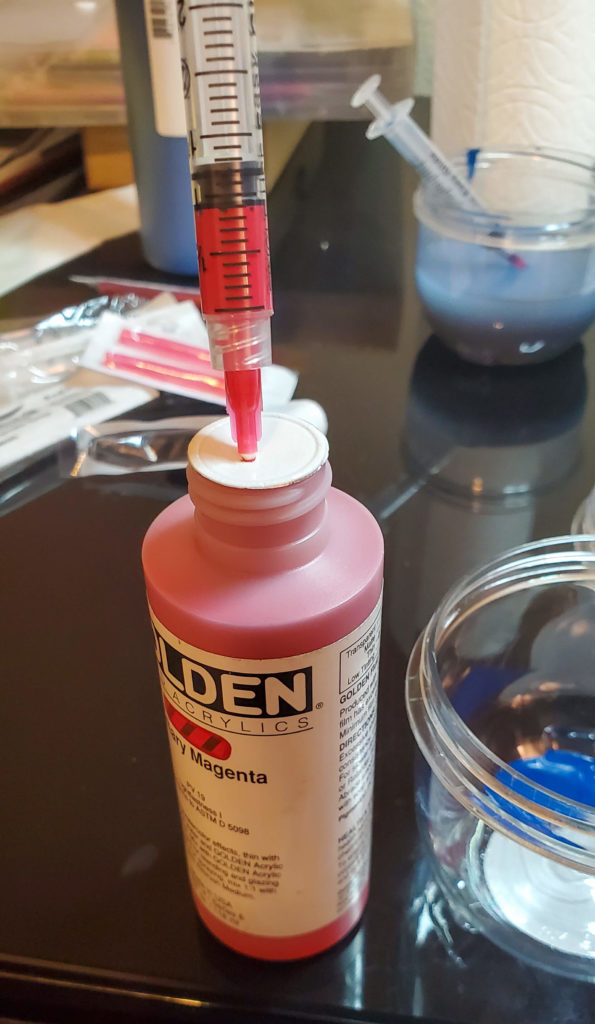
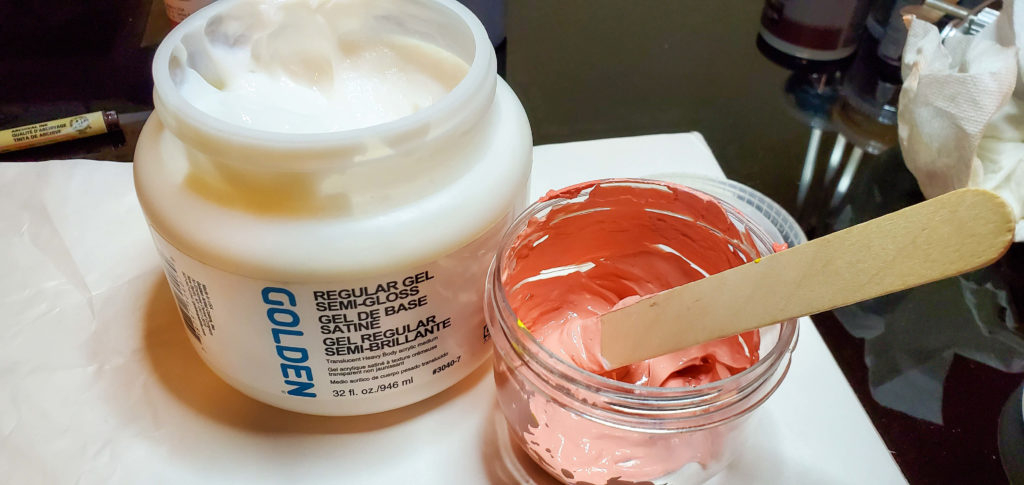
Daniel,
I read your article with interest as I’m trying to covert CMYK formulas into craft paint for model railroading projects. I have two questions. First, what do you do if the %s add up to over 100%? Do you just do it as a proportion? Next, since these %s are the amount of coverage on an area of usually white paper, what role does white paint play in this formula if any? Thanks!
Hey Bill, I’m using the proportions. CMYK is expressed as the percent of coverage. So you could cover 100% of the area with Cyan then 100% of the area in Magenta, and then 100% in Yellow. So they do not need to add up to 100.
If you’ve ever examined an old printed comic, you could easily pick out each dot of color. If they wanted a green, they could fill 50% of an area in cyan dots and then print magenta dots over that at about 25% of the space.
This paint mixing method is not perfect and there have been colors I tried to mix that has come out completely wrong. I wish I would have documented some of them as examples, but I think the issue comes down to which pigments are in the paints I’m using. So far, this has been pretty rare. I’ve mixed a lot of colors and 2 or 3 times I have just needed to figure the mixture out on my own.
There may be a correct amount of white to add, but honestly, I just keep mixing in white or black until I get the tint I want.
(Disclaimer: IANAPainter, and haven’t don’t printing since I was in high school… and my background is science, not art.)
They shouldn’t add to over 100% in theory
The reason is that CMYK is missing white because that comes from the paper so some of the percentage is white.
However, you can’t just invert use the K percentage or the sum to derive the white because a 100% coverage of CMY in print yields chromatic black (black, it not as dark, and it will have a tone to it because the CMY isnt perfect hence the K).
If the sum is greater than 100% then I guess the tool may be accounting for this because print color space isn’t as wide as sRGB, there is pigment knowledge so it is trying to reach a tone easily to reach “in practice” by the complementary color, or some such so it’s trying to get the gamut to cover via the shift caused by this chromatic black. In theory, one of the CMYK values should be zero.
It doesn’t matter anyway because the only thing that matters to get the HUE is the relative ratios of the TOP TWO colors.
This then gets to the “paint mixing is not perfect” part of the reply. Different pigments should have different tinting strength — the easiest is to compare nearly the same amount of Mars Black vs. Ivory Black added to Titanium White to produce different values of gray.
I’d imagine if you are buying paints from the same brand labeled primary cyan, primary magenta, and primary yellow, they are formulated in such a way (dilution) such that their opacity when covering is the same and can map directly onto what a CMYK math conversion from RGB will spit out. But coverage/opacity doesn’t have to be the same as tinting strength which covers mixability,
(For Golden, I noticed they are using the same pigment in “primary magenta” as in their existing magenta in the line already which would be the same color and confused me. But this would make sense if they either are accounting for opacity by diluting it or they’re designing these for mixibility.)
To figure that out, I think you’ll have to do experiments to figure what relative dilutions you need to get that pure red green and blue hues when mixing (e.g. 0% in two categories, or the complementary RGB colors to exactly match hex values).
This gets to your “add white” stuff. White and black change the VALUE of the paint, but since it isn’t light, white is not light so you can’t add them without changing the TONE (e.g. if you add black or the complementary color to a mix, you can’t add white in to get back the lost saturation because the combination is like adding gray not brightening it). I believe the way painters get to those lower value colors (skin tones, browns, etc) is by mixing with the complementary color, probably because it’s really hard to get that exact color by mimicing Seurat and painting in tiny dots of primary CMYK . If you mix with grays onky, you can’t get to parts of the gamut that the complementary color plus white will get.
Hope this makes sense. I’m sorry I can onky approach this theoretically.
This is great. As a graphic designer that’s getting back into painting, understanding CMYK colour mixing is a great help!
Green is not a primary colour. Your confusing RGB (light eg computer) with RBY for paint mixing (red blue and yellow paint). This confuses a lot of people.
That’s funny, I totally messed that up and I know better than that. You’re the first person to say anything about it.
Thanks for the article and the comments from everyone. I am in my own hellacious process of using the color picker in Photoshop to sort out the mixture of some colors in a digital photo I took of some fields near my house that is driving an acrylic landscape painting to my left. I’m not trying to be too exact here (the project is chasing some Thiebauds I saw recently), but I’d like to be close on a few colors. The best tack seems to use the CMYK info in the picker to build up the right colors in my paints, but, still, it’s breaking my head. Your article helps.
CMYK is typically referred to as “process” colors or pigments. They are the subtractive hues that work best for mixing pigments (pigment absorbs light thus it subtracts). Primary is a word used to describe RYB hues in color theory based on the Bauhaus school of art which is cultural (and commonly taught in grade schools that one can mix all colors from which is false). I refer to them as the addictive hues being RGB and subtractive hues are CMY.
To create gray, it appears that the proportion of white added to the mix should be equal ro 1 – K. As a matter of fact, to create gray, no amounts of CMY are needed, only mix proportions of K (black) and 1 – K (white).
To mix paints using subtractive primaries CMY, the right amounts of black and white are also needed. I was not able to produce an accurate paint color of a given RGB by mixing CMYK as determined by the online RGB to CMYK converters and also adding white for an amount equal to 1 – K to the mix.
Has anyone figures this out? Thanks!